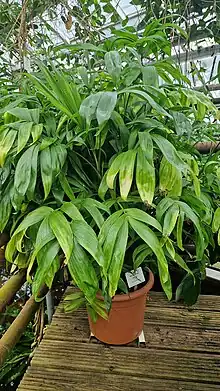| Wendlandiella | |
|---|---|
 | |
| Scientific classification | |
| Kingdom: | Plantae |
| Clade: | Tracheophytes |
| Clade: | Angiosperms |
| Clade: | Monocots |
| Clade: | Commelinids |
| Order: | Arecales |
| Family: | Arecaceae |
| Subfamily: | Arecoideae |
| Tribe: | Chamaedoreeae |
| Genus: | Wendlandiella Dammer |
| Species: | W. gracilis |
| Binomial name | |
| Wendlandiella gracilis | |
| Synonyms[1] | |
| |
Wendlandiella is a genus of one species of palms found in Peru, Bolivia and Acre state in Brazil.[1][2] The genus is named after Hermann Wendland.
The only recognized species is Wendlandiella gracilis. It is dioecious, with male and female flowers on separate individuals.[3] It has three varieties, regarded as distinct species by some authors:[1]
- Wendlandiella gracilis var. gracilis – Acre, northern Peru
- Wendlandiella gracilis var. polyclada (Burret) A.J.Hend. – northern Peru
- Wendlandiella gracilis var. simplicifrons (Burret) A.J.Hend. – Peru, Bolivia
References
- 1 2 3 Kew World Checklist of Selected Plant Families
- ↑ Lorenzi, H., Noblick, L.R., Kahn, F. & Ferreira, E. (2010). Brazilian Flora Arecaceae (Palms): 1-268. Instituto Plantarum de Estudos da Flora LTDA, São Paulo, Brazil.
- ↑ "Structural biology and evolution in the monotypic Amazonian palm Wendlandiella (Arecoideae: Chamaedoreeae)". Candollea. 74: 15. 2019. doi:10.15553/c2019v741a3. S2CID 198156951.
This article is issued from Wikipedia. The text is licensed under Creative Commons - Attribution - Sharealike. Additional terms may apply for the media files.
